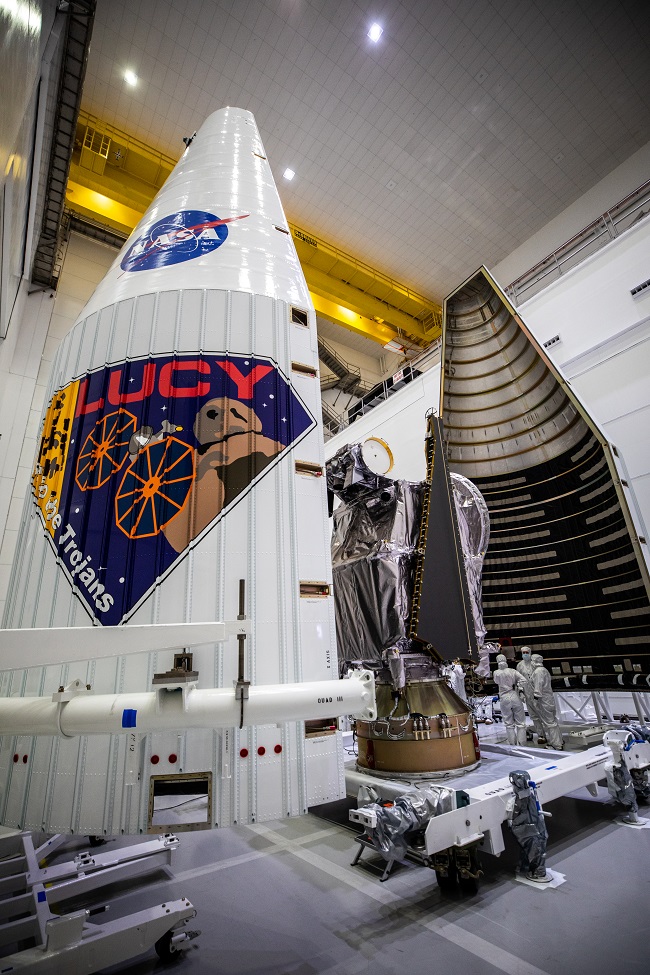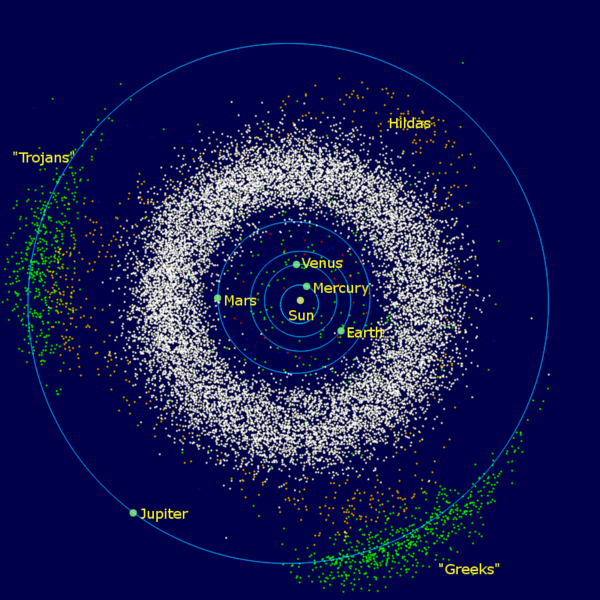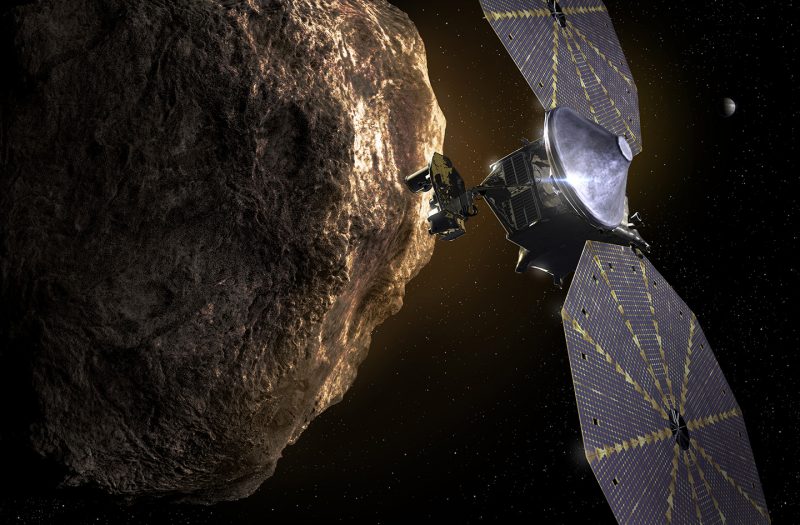
Lucy spacecraft to launch Saturday
The Lucy spacecraft – named for a famous fossilized skeleton found in 1974 in Africa – is set to launch from Cape Canaveral, Florida, on Saturday, October 16, 2021. With the help of three gravity assists from Earth, Lucy will travel almost 4 billion miles (6 billion km) in 12 years, exploring one asteroid in the main asteroid belt and seven of Jupiter’s Trojan asteroids. The Trojans move in Jupiter’s orbit around the sun and have never been explored before. And scientists view them as fossils that are left over from the formation of the solar system.
Our fossilized ancestor called Lucy dates to some 3.2 million years ago. The skeleton of the fossil Lucy provided unique insight into human evolution. Likewise, the Lucy space mission will hopefully provide insight into our solar system’s evolution. Astronomer Hal Levison of the Southwest Research Institute (SwRI) in Boulder, Colorado, leads the Lucy mission. He spoke about Lucy’s journey to Jupiter’s Trojans and about how the mission got its name:
The Trojan asteroids are leftovers from the early days of our solar system, effectively fossils of the planet formation process. They hold vital clues to deciphering the history of our solar system. The Lucy spacecraft, like the human ancestor fossil for which it is named, will revolutionize the understanding of our origins.
Lucy’s 4-billion-mile journey will take it out to the orbit of Jupiter and the realm of Trojan asteroids, then back in toward Earth for gravity assists three times. This will be the first time a spacecraft has ever returned to Earth’s vicinity from the outer solar system.

Target: Trojan asteroids
Trojan asteroids are a unique group of rocky bodies. Left over from the formation of the solar system, they orbit the sun on either side of Jupiter. No spacecraft has previously explored this collection of solar system fossils. Jupiter’s gravity traps these asteroids in two swarms in its orbit, with some ahead of the planet and some trailing behind.
Deputy principal investigator Cathy Olkin said:
Lucy’s ability to fly by so many targets means that we will not only get the first up-close look at this unexplored population, but we will also be able to study why these asteroids appear so different. The mission will provide an unparalleled glimpse into the formation of our solar system, helping us understand the evolution of the planetary system as a whole.

Launching the Lucy spacecraft
Team members for the Lucy mission have spent weeks at NASA’s Kennedy Space Center prepping and practicing for the launch. Levison said the spacecraft is ready, elaborating:
Launching a spacecraft is almost like sending a child off to college. You’ve done what you can to get them ready for that next big step on their own. Lucy is ready to fly.
Lucy’s first attempt at launch will be at 5:34 a.m. EDT (09:34 UTC) on Saturday, October 16. The team will check in at 1 a.m. (05:00 UTC) to begin their run-through of the full launch countdown procedures. If weather or other circumstances delay the October 16 launch, a 23-day launch window will give the team additional opportunities to send Lucy off on its journey.

Bottom line: The Lucy spacecraft is to launch on Saturday, October 16, 2021. It will journey to Jupiter’s Trojan asteroids, fossils of the solar system’s formation that lie along Jupiter’s orbit.
Via Southwest Research Institute
Read more about the Lucy mission
The post Lucy spacecraft to launch to Trojan asteroids first appeared on EarthSky.
from EarthSky https://ift.tt/3voSnYt

Lucy spacecraft to launch Saturday
The Lucy spacecraft – named for a famous fossilized skeleton found in 1974 in Africa – is set to launch from Cape Canaveral, Florida, on Saturday, October 16, 2021. With the help of three gravity assists from Earth, Lucy will travel almost 4 billion miles (6 billion km) in 12 years, exploring one asteroid in the main asteroid belt and seven of Jupiter’s Trojan asteroids. The Trojans move in Jupiter’s orbit around the sun and have never been explored before. And scientists view them as fossils that are left over from the formation of the solar system.
Our fossilized ancestor called Lucy dates to some 3.2 million years ago. The skeleton of the fossil Lucy provided unique insight into human evolution. Likewise, the Lucy space mission will hopefully provide insight into our solar system’s evolution. Astronomer Hal Levison of the Southwest Research Institute (SwRI) in Boulder, Colorado, leads the Lucy mission. He spoke about Lucy’s journey to Jupiter’s Trojans and about how the mission got its name:
The Trojan asteroids are leftovers from the early days of our solar system, effectively fossils of the planet formation process. They hold vital clues to deciphering the history of our solar system. The Lucy spacecraft, like the human ancestor fossil for which it is named, will revolutionize the understanding of our origins.
Lucy’s 4-billion-mile journey will take it out to the orbit of Jupiter and the realm of Trojan asteroids, then back in toward Earth for gravity assists three times. This will be the first time a spacecraft has ever returned to Earth’s vicinity from the outer solar system.

Target: Trojan asteroids
Trojan asteroids are a unique group of rocky bodies. Left over from the formation of the solar system, they orbit the sun on either side of Jupiter. No spacecraft has previously explored this collection of solar system fossils. Jupiter’s gravity traps these asteroids in two swarms in its orbit, with some ahead of the planet and some trailing behind.
Deputy principal investigator Cathy Olkin said:
Lucy’s ability to fly by so many targets means that we will not only get the first up-close look at this unexplored population, but we will also be able to study why these asteroids appear so different. The mission will provide an unparalleled glimpse into the formation of our solar system, helping us understand the evolution of the planetary system as a whole.

Launching the Lucy spacecraft
Team members for the Lucy mission have spent weeks at NASA’s Kennedy Space Center prepping and practicing for the launch. Levison said the spacecraft is ready, elaborating:
Launching a spacecraft is almost like sending a child off to college. You’ve done what you can to get them ready for that next big step on their own. Lucy is ready to fly.
Lucy’s first attempt at launch will be at 5:34 a.m. EDT (09:34 UTC) on Saturday, October 16. The team will check in at 1 a.m. (05:00 UTC) to begin their run-through of the full launch countdown procedures. If weather or other circumstances delay the October 16 launch, a 23-day launch window will give the team additional opportunities to send Lucy off on its journey.

Bottom line: The Lucy spacecraft is to launch on Saturday, October 16, 2021. It will journey to Jupiter’s Trojan asteroids, fossils of the solar system’s formation that lie along Jupiter’s orbit.
Via Southwest Research Institute
Read more about the Lucy mission
The post Lucy spacecraft to launch to Trojan asteroids first appeared on EarthSky.
from EarthSky https://ift.tt/3voSnYt

Aucun commentaire:
Enregistrer un commentaire